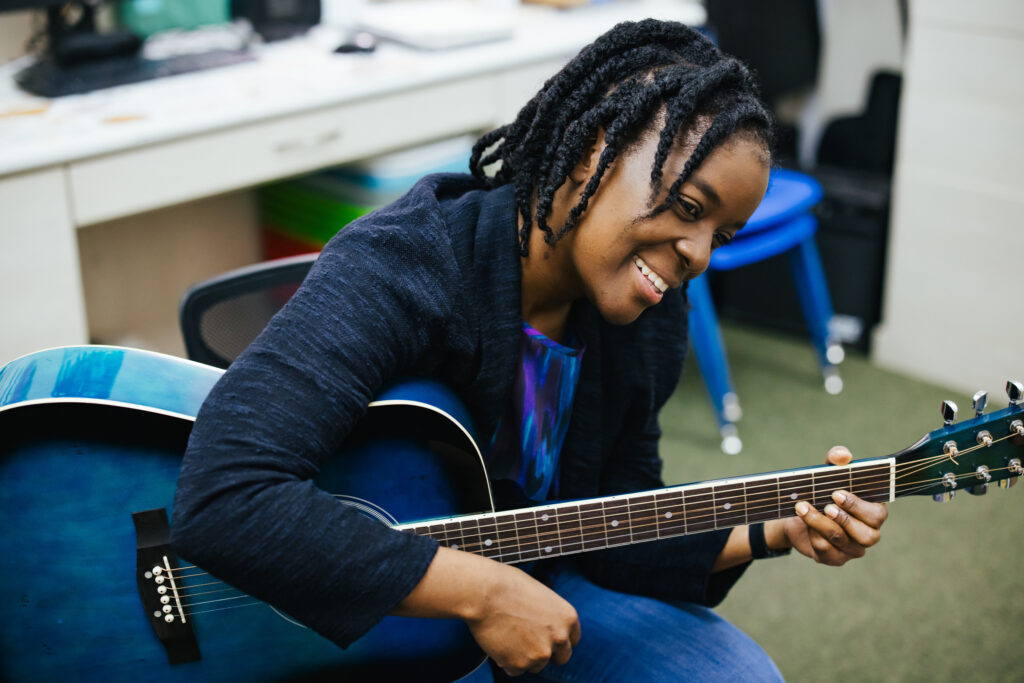By: Michelle Hintz, PsyD, MT-BC & BriAnne Weaver, MT-BC
Like most parents of a preschooler with developmental delays, Noah’s parents were eager to get him the help he needed. At 3 years old, Noah was an especially cute and curious boy. He was always moving – he enjoyed playing outside, loved dinosaurs, and building with blocks. When busy with his play, Noah seemed like a typical boy.
Yet, Noah’s communication was limited and he only used a handful of single words, often to make a request for a toy or his favorite snack. Noah’s mother was also concerned about his lack of interest in the children at his daycare. And she noticed that his tantrums were becoming more frequent. Sometimes, she could easily figure out the reason – such as he wanted something opened or was frustrated because something wasn’t working. But she also noticed that Noah was becoming more frustrated when she couldn’t understand what he wanted.
The Evaluation Process
Noah’s parents brought their concerns to his pediatrician, who referred them to a child psychologist for a developmental evaluation. The evaluation process was more detailed than they expected, but Noah’s parents were relieved to finally have someone who validated their concerns and had a plan to understand Noah’s condition.
After the evaluation, Noah was diagnosed with autism spectrum disorder, and given a list of recommendations for his treatment. In addition to referrals for the “typical” therapies such as applied behavior analysis (ABA), speech therapy, and occupational therapy, it was also recommended that Noah receive music therapy.
A New Plan for Noah
Noah’s parents met with the music therapist, BriAnne Weaver, who asked about Noah’s favorite toys, the programs he watched, his ability to imitate, and how he tended to communicate his needs and wants. Together with Noah’s parents, BriAnne decided to prioritize his language development. She explained the developmental need for Noah to establish more imitation skills and what she called “social approach behaviors.” The music therapist described that the sessions would include playing instruments, movement, and of course some singing.
Noah’s first music therapy sessions were challenging. He cried, resisted any offers to try instruments, and wasn’t interested in anything that the music therapist had to offer. So, BriAnne picked up her guitar and played a hello song in rhythm with his crying. She used a gentle voice and used his name in the song. She explored the instruments around the room, but he wasn’t interested. Noah didn’t seem to notice or care…that is until she brought out a large floor drum. Now that caught his attention!
Tailored Therapy to Bridge the Gap
As sessions continued, BriAnne continued to create musical experiences that followed Noah’s interest. She used the floor drum as an opportunity for parallel play, for call and response, for matching his tempo and eventually for adding words to the playing. She used ‘errorless’ strategies – making every response he gave somehow fit the music she provided. BriAnne created a song one of his favorite songs while playing the guitar and Noah reached to strum. The connection was made. Through the universal language of music, she bridged the gap between Noah’s world and the one around him, meeting him precisely where he was at. And within a few months, Noah was labeling things used in therapy – guitar, drum, book, ball…
With each session, Noah’s progression was nothing short of remarkable. From tentative smiles to active participation, he began to explore the depths of musical expression, eagerly pressing keys and strumming strings alongside his therapist. As the melodies unfolded, so did Noah’s own voice and engageability. Through the structured yet inherently flexible nature of music therapy, Noah found avenues for communication that transcended traditional speech. From counting to reciting his ABCs, from imitating animal sounds to making choices through pictures, Noah’s world expanded with each musical exchange.
The benefits of music therapy for children like Noah are often profound and multifaceted. Beyond facilitating non-verbal communication and enhancing language development, music therapy cultivates essential skills such as attention, focus, and social interaction. Through musical exchanges with therapists and peers alike, children learn the art of turn-taking, listening, and collaboration in a nurturing and supportive environment.
The Transformative Power of Music Therapy
Noah’s story is a testament to the transformative power of music therapy as an essential component of a child’s treatment program. Music therapists work in tandem with other therapeutic modalities and address similar clinical goals. Music therapy does not aim to teach musical skills, but rather to use music experiences as a catalyst for supporting development in communication, social skills, and behavior especially for those navigating the complexities of autism spectrum disorder and developmental delays.
Noah’s journey is a reminder that using music as therapy creates boundless opportunities for growth, connection, and transformation. Through music therapy and the connection with their music therapist, children like Noah find their voices, their rhythms, and their place in the world—a world filled not with silence, but with the vibrant melodies of possibility and promise.


